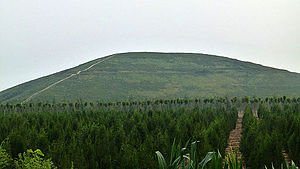Emperor Mjen (Themiclesia): Difference between revisions
No edit summary |
No edit summary |
||
| Line 75: | Line 75: | ||
During the reign of Emperor Mjen, Themiclesia continued to urbanize and industrialize. | During the reign of Emperor Mjen, Themiclesia continued to urbanize and industrialize. | ||
==Burial== | |||
[[File:Changling 1.jpg|thumb|The tumulus of Emperor Mjen; burial chamber was 20 m under surface. It was the first royal tomb to be constructed with the aid of power machinery.]] | |||
Revision as of 05:06, 9 October 2019
| Emperor Mjen | |||||||||
|---|---|---|---|---|---|---|---|---|---|
| Reign | Jun. 1, 1864 – Mar. 22, 1885 | ||||||||
| Predecessor | Emperor Tjang | ||||||||
| Successor | Emperor Gar | ||||||||
| Prince of Ngljakw-lang (櫟陽王) | |||||||||
| Reign | 1832 – Jun. 1, 1864 | ||||||||
| Predecessor | title created | ||||||||
| Successor | title absorbed | ||||||||
| Born | 23 February 1820 Middle Palace, Kien-k'ang | ||||||||
| Died | 22 March 1885 (aged 65) Hên-lang Palace, Kien-k'ang | ||||||||
| Burial | Kjung Mausoleum (恭陵) | ||||||||
| Empress Hruh-tjaw (孝昭皇后) | |||||||||
| Issue |
| ||||||||
| |||||||||
| Religion | State cult of Themiclesia | ||||||||
Emperor Mjen (Shinasthana: 文皇帝, mjen-gwang-têgh; Feb. 23, 1820 – Mar. 22, 1885) reigned as Emperor of Themiclesia between Jun. 1, 1864 – Mar. 22, 1885. He was the fourth of five legitimate sons of Emperor Hngjanh and inherited the throne from his childless brother, Emperor Tjang; reigning for just over 20 years, he was succeeded by his second legitimate son, Emperor Gar. His reign is remembered as a stable and prosperous one. The monarchy relegated to political passivity during the first half of the century, he actively sought to re-establish the monarchy in the administration, though he affirmed principles of parliamentary democracy that had flourished before him. While remembered as a political reformer, he is noted for astonishingly dismissive views of military development and social change, casting him as an arch-conservative in some sense.
He was, at age 4, engaged to the future Empress Hruh-tjaw, which he consummated under the auspices of his father Emperor Hngjanh, once legally marriagable. The empress, the same age as Emperor Mjen, was not close to him, but she bore him seven children. They met each other fewer than sixty times during their lifetimes. Though the tradition of the Themiclesian royal family, which confined each member to their own courtiers from childhood, was starting to wane during his reign, Emperor Mjen sought to reinforce these traditions, seeing them as imperative and natural to the maintenance of the royal family's supremacy and distinctiveness.
During the reign of Emperor Mjen, Themiclesia continued to urbanize and industrialize.
